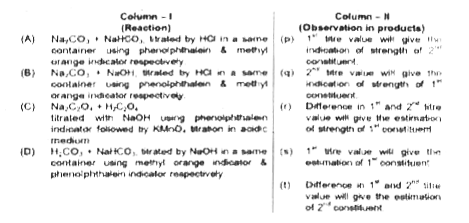Match the entries in Column I with the correctly related quantum number(s) in Column II. Indicate your answer by darkening the appropriates bubbles of the 4×4 matrix given in the ORS

The correct Answer is:(A-q; B-s; C-p,q,r; D-p)
A. Orbital angular momentum (L)
=√l(l+1)=h2π
B. One electron wave function obeying Pauli exclusion principle is related to electron spin quantum number (+12,−12)
C. Shape depends upon l, size depends upon n and orientation depends upon m.
D. Hydrogen -like atoms have only 1s orbital which is spherical. Its wavefunction depends on the radial part, i.e., distance from the nucleus and hence on the value of n.
Topper's Solved these Questions
- STRUCTURE OF ATOMBOOK - PRADEEPCHAPTER - STRUCTURE OF ATOMEXERCISE - Competition Focus (JEE (Main and Advanced)/Medical Entrance (VII. Integer Type Questions)
11 Videos
- STRUCTURE OF ATOMBOOK - PRADEEPCHAPTER - STRUCTURE OF ATOMEXERCISE - Competition Focus (JEE (Main and Advanced)/Medical Entrance (VIII. Numerical Value Type Question)
1 Videos
- STRUCTURE OF ATOMBOOK - PRADEEPCHAPTER - STRUCTURE OF ATOMEXERCISE - Competition Focus (JEE (Main and Advanced)/Medical Entrance (V. Matching type Questions)
3 Videos
- STATES OF MATTER: SOLID MATTERBOOK - PRADEEPCHAPTER - STATES OF MATTER: SOLID MATTEREXERCISE - COMPETITION FOCUS (ASSERTION-REASON)
17 Videos
- THERMODYNAMICSBOOK - PRADEEPCHAPTER - THERMODYNAMICSEXERCISE - MULTIPLE CHOICE QUESTION ( BASED ON PRACTICAL CHEMISTRY)
3 Videos
Similar Questions
Match the entries in Column I with the correctly related quantum number(s) in Column II. Indicate your answer by darkening the appropriate bubbles of the 4×4 matrix given in the ORS.
Column IColumn II(A)Orbital angular momentum of the(P)Principal quantum numberelectron in a hydrogen-like atomic orbital(B)A hydrogen-like one-electron wave(Q)Azimuthal equation numberfunction obeying Pauli principle(C)Shape.size and orientation of hydrogen like atomic orbitals(R)Magnetic quantum number(D)Probability density of electron at the nucleus(S)Electron spin quantum numberin hydrogen-like atom
View SolutionMatch the conversions in Column I with the type(s) of reaction(s) given in Column II. Indicate your answer by darkening the appropriate bubbles of the 4×4 matrix given in the ORS.

View SolutionMatch the compounds in Column I with their characteristic test(s)/reaction(s) given in Column II. Indicate your answer by darkening the appropriate bubbles of the 4 × 4 matrix given in the ORS.
Column I

Column II
(P) sodium fusion extract of the compound gives Prussian blue colour with FeSO4
(Q) gives positive FeCl3 test
(R) gives white precipitate with AgNO3
(S) reacts with aldehydes to form the corresponding hydrazone derivative
View SolutionThe section contains one question. Each question contains statements given in two columns which have to be matched . The statements in Column I are labelled A, B, C and D , while the statements in Column II are labelled p,q, r, s and t. Any given statement in Column I can have correct matching with ONE OR MORE statements (s) in Column II . The appropriate bubbles corresponding to the answers to these questions have to be darkened as illustrated in the following example:
If the correct matches are A-p, s and t, B-q and r, C-p and q, and D-s and t, then the correct darkening of bubbles will look like the following .

Match the reactions in Column I with nature of the reactions/type of the products in Column II. Indicate your answer by darkening the appropriate bubbles of the 4×4 matrix given in the ORS.

View SolutionMatch the compounds in Column I with their characteristic test(s)/reaction(s) given in column II. Indicate your answer by darkening the appopriate bubbles of the 4×4 matrix given in the ORS.

View SolutionMatch the compounds in Column-Iwith their characterstic test(s)/reaction(s) given in Column-II. Indicate your answerby darkening the appropriate bubbles of the 4 x 4 matrix given in the ORS.

View SolutionColumn I gives a listof possible set of parameters measured in some experiments. The variations of the parameters in the form of graphs are shown in Column II. Match the set of parameters given in Column I with the graphs even in Column II. Indicate your answer by darkening the appropriate bubbles of the 4×4 matrix given in the ORS.

View SolutionMatch the crystal systems/unit cells mentioned in colunn I with their characteristic features mentioned in column II. Indicate your answer by darkening the appropriate bubbles of the 4×4 matrix given in the ORS.
Column I Column II (A) simple cubic and face-centred cubic(p) have these cell parameters a=b=c andα=β=γ(B) Cubic and rhombohedral (q) are two crystal systems(C) Cubic and tetragonal(r) have only two crytallographic angles of 90∘(D) Hexagonal and monoclinic (s) belong to the same crystal system
View SolutionMatch the crystal system / unit cells mentioned in Column I with their characteristic features mentioned in Column II. Indicate your answer by darkening the appropriate bubbles of the 4 × 4 matrix given in the ORS.
Column I
(A) simple cubic and face-centred cubic
(B) cubic and rhombohedral
(C) cubic and tetragonal
(D) hexagonal and monoclinic
Column II
(P) have these cell parameters a = b = c and α=β=γ
(Q) are two crystal systems
(R) have only two crystallographic angles of 90°
(S) belong to same crystal system
View SolutionMatch the complexes in column I with their properties listed in column II. Indicate your answer by darkening the appropriate bubbles of the 4×4 matrix given in the ORS.

View Solution
